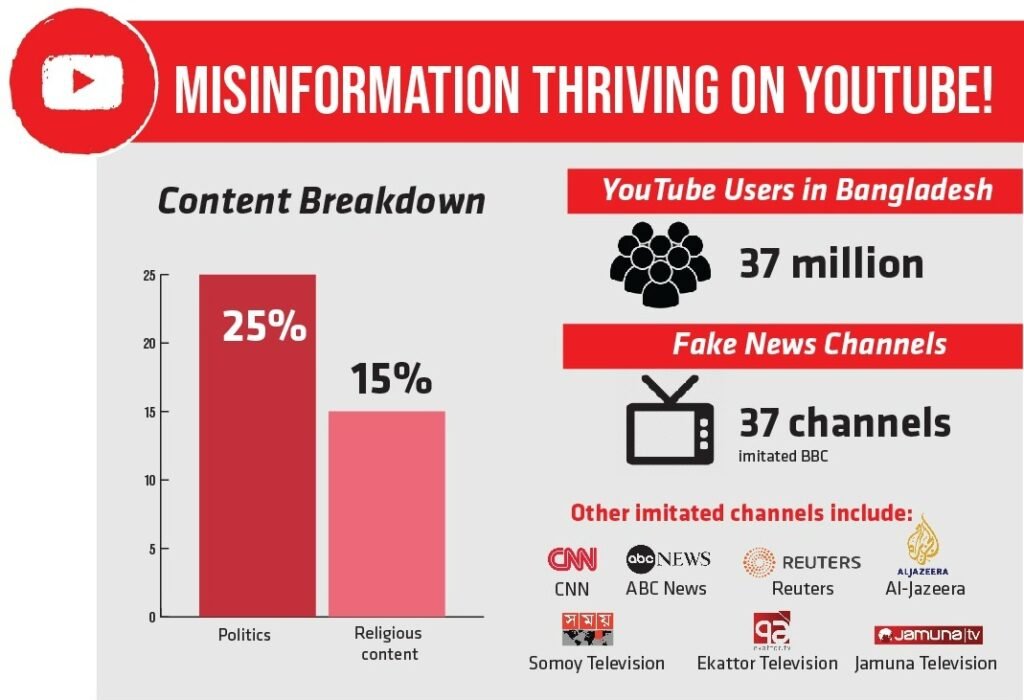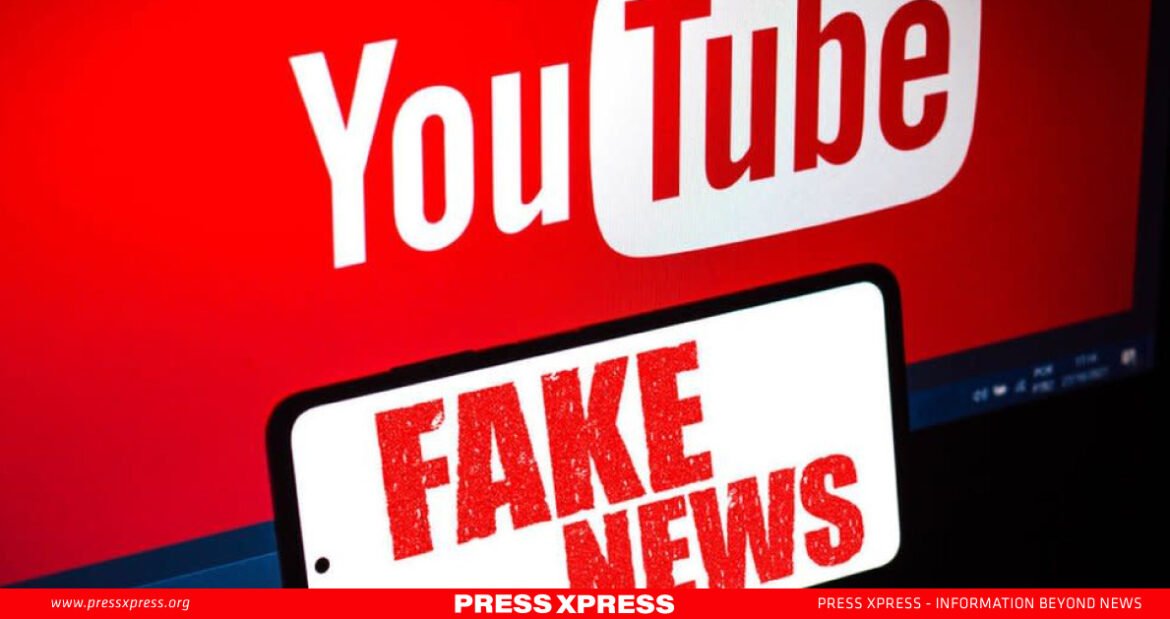Key Highlights:
- In April 2024, YouTube removed 150,000 videos from Bangladesh
- Fake videos were posted by 541 YouTube channels, with 16.5% (89) of those channels verified by YouTube
- According to DataReportal, ads shown on YouTube reached 43.04% of internet users in Bangladesh in January this year
Rumors and misinformation have long been part of Bangladesh’s history. One of history books’ oldest and most prominent rumors is about cartridges greased with beef and pork fat, which allegedly triggered the Sepoy Rebellion of 1857. However, the medium of communication and the development of tools that allow misinformation to be shared instantly across the globe have changed over the years.
You Can Also Read: MISINFORMATION TOPS GLOBAL RISKS: SOUNDS ALARM
Platforms like YouTube host videos with incorrect dates of deaths, misleading news about the prime minister, ministers, and armed forces, and false information on education, religion, games, entertainment, and disasters. These videos often feature ads for various brands and products, including locally popular businesses, generating profits for the platform.
Researchers at Dismisslab analyzed 2,042 fact-check articles published between January 1, 2023, and September 30, 2023, on 7 fact-checking websites covering Bangladesh, including Dismislab, Rumor Scanner, Boom, etc. They searched the titles of false or misleading claims from these articles on YouTube to identify corresponding videos between November and December 2023.
In April 2024, YouTube removed 150,000 videos from Bangladesh. Globally, the platform eliminated over 9 million videos. Among the 30 countries listed, India had the highest number of removals, with up to 2.25 million videos taken down. Following India, Singapore, and the United States ranked second and third, with 12.4 million and 7.8 million videos removed, respectively. Indonesia ranked fourth with over 770,000 videos removed, while Bangladesh was in the 8th position.

How Fake News Channels Are Fooling Millions?
Researchers found “700 unique pieces of misinformation content, already fact-checked by independent fact-checkers, have been alive and thriving on YouTube, generating views and engagement until March 2024. Politics dominated these videos at 25%, followed by religious content (about 15%), sports, and disasters.”
According to the Sample Vital Statistics-2023 report by the Bangladesh Bureau of Statistics, 50% of individuals aged over 15 use the internet. DataReportal, a website that tracks social media usage, reported that there were around 37 million YouTube users in Bangladesh at the beginning of this year.
Among the fake news channels identified, 37 have imitated the BBC. Other well-known news channels copied by these fake channels include CNN, ABC News, Reuters, Al-Jazeera, Somoy Television, Ekattor Television, and Jamuna Television.
One such fake news channel is ‘Al-Jazeera Bangla.’ Al-Jazeera does not have a YouTube channel by this name; it is a counterfeit channel using Al-Jazeera’s logo. Researchers analyzed 168 video contents from 12 YouTube channels that copied the BBC, revealing that the headlines often did not match the video content.

Ads Unwittingly Supporting Fake News Channels
Fake videos were posted by 541 YouTube channels, with 16.5% (89) of those channels verified by YouTube. Among the analyzed channels, 64 were found to have spread more than one misinformation video.
Of the 668 reported pieces of content in users’ report history, YouTube took action on only 25, which included 5 Shorts and 20 videos. Out of these, 22 videos were entirely removed, and 19 associated channels were terminated. One video was removed for violating YouTube’s policy on harassment and bullying, while three had age restrictions applied.
Advertisements from 83 different brands were seen in videos containing false or misleading information, with one-third being from foreign companies targeting a Bangladeshi audience. Most ads in misinformation videos came from sectors like gaming, telecommunications, e-commerce, and consumer goods.
The gaming app Hero Wars had the highest number of ads in misinformation videos, followed by Robi Axiata Limited, a Bangladeshi mobile network operator, and Sting Energy Drink, a PepsiCo product, each appearing in 16 videos.
Fake Videos on YouTube: A Statistical Overview
- Channels Involved:
- Total Channels: 541
- Verified Channels: 89 (16.5%)
- Channels Spreading Misinformation Videos: 64
- YouTube’s Responseto Reported Content:
- Reported Content: 668 pieces
- Actions Taken: 25 (3.7%)
- Videos Removed: 22
- Channels Terminated: 19
- Videos with Age Restrictions: 3
- Videos Removed for Harassment/Bullying: 1
- Shorts Removed: 5
YouTube’s Monetization Blackout
According to DataReportal, ads shown on YouTube reached 43.04% of internet users in Bangladesh in January this year, generating up to $13.4 million annually solely from advertising revenue.
On November 17, 2023, YouTube removed the display of monetization status from the channel page code, restricting researchers’ and creators’ ability to verify who is accepted into the YouTube Partner Program for content monetization.
YouTube offers various ad formats, including skippable in-stream ads, non-skippable in-stream ads, in-feed video ads, bumper ads, out-stream ads, and masthead ads. The appearance of ads on videos is influenced by numerous factors, such as demand and ad auctions.
AI Uncovers Surge in YouTube Climate Denial Content
The Center for Countering Digital Hate (CCDH) employed artificial intelligence to analyze transcripts of 12,058 videos spanning the last 6 years across 96 YouTube channels owned by Alphabet Inc. These channels disseminated content that challenges the scientific consensus on climate change, suggesting that human activities do not significantly contribute to long-term shifts in temperature and weather patterns.
In the past year, 70% of the analyzed climate denial content on these channels focused on discrediting climate solutions as impractical, portraying global warming as benign or beneficial, or questioning the reliability of climate science and environmental advocacy. This marks a significant increase from 35% observed 5 years ago.
The Spread of Climate Denial on YouTube
- Channels Analyzed: 96 YouTube channels
- Videos Analyzed: 12,058 videos over 6 years
Key Findings:
- Focus Areas of Climate Denial Content:
- Discrediting Climate Solutions: 70% in the past year (up from 35% 5 years ago)
- Portraying Global Warming as Benign or Beneficial
- Questioning the Reliability of Climate Science
Misinformation Thrives Despite Content Policies
YouTube has faced persistent scrutiny for its role in combating misinformation. In a 2022 letter, 80 fact-checking groups criticized YouTube, stating, “The platform is being exploited by unscrupulous actors to manipulate and deceive others, organize, and raise funds. Current measures are deemed inadequate.”
Alphabet Incorporation, headquartered in the United States, serves as the parent company of YouTube. YouTube’s policies strictly prohibit content copying and duplication. Despite identifying clear violations by 58 channels, these channels remain active, with their videos even monetized through advertisements.
This situation implies that YouTube profits from these deceptive channels. Additionally, many of these channels have been misleadingly verified with the blue checkmark, misleading viewers into thinking they are legitimate and endorsed by YouTube.
YouTube has become a double-edged sword in Bangladesh’s information landscape. While it offers a platform for creativity and knowledge-sharing, it also serves as a breeding ground for misinformation. As fake news channels masquerade as reputable sources and AI-driven content floods the platform, the line between fact and fiction blurs. In the end, the power to combat misinformation lies in our hands – and our thumbs.


